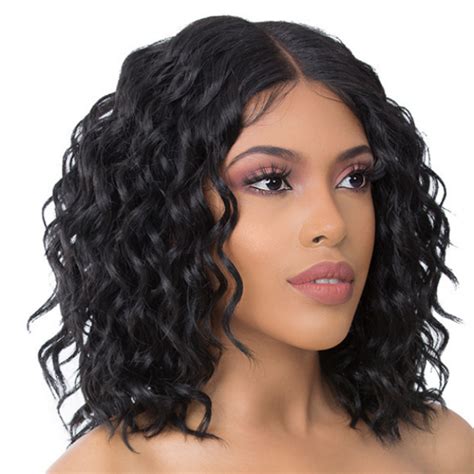Introduction
Wigs have become an increasingly popular fashion accessory, providing versatility, style, and convenience. From synthetic wigs to human hair wigs, the market offers a wide range of options to suit every need and preference. In this comprehensive guide, we delve into the world of wigs, exploring the benefits, types, maintenance, and styling tips to empower you with the knowledge to make informed choices.

Synthetic Wigs: Affordable Options with Versatile Styles
Synthetic wigs are made from artificial fibers, such as nylon, acrylic, and polyester. They offer the following advantages:
- Affordability: Synthetic wigs are typically less expensive than human hair wigs, making them a budget-friendly option.
- Variety of Styles: Synthetic fibers allow for endless styling possibilities, from sleek bobs to voluminous curls.
- Heat Resistance: Some synthetic wigs are heat-resistant, allowing you to style them with heat tools.
Human Hair Wigs: Natural Look and Customizable Styling
Human hair wigs are made from real human hair, providing the most natural look and feel. They offer the following benefits:
- Natural Appearance: Human hair wigs blend seamlessly with your own hair, creating a realistic and undetectable look.
- Customizable Styling: Human hair wigs can be cut, colored, and styled like your own hair, giving you unlimited styling options.
- Durability: Human hair wigs are generally more durable than synthetic wigs and can last longer with proper care.
Pain Points: Challenges Faced with Wigs
While wigs offer numerous benefits, they also come with certain challenges:
- Scalp Irritation: Some wigs can cause scalp irritation due to friction or allergic reactions.
- Tangling and Matting: Synthetic wigs are prone to tangling and matting, especially if not properly cared for.
- Short Lifespan: Synthetic wigs typically have a shorter lifespan than human hair wigs.
Motivations: Why Wear Wigs?
Despite the challenges, wigs are highly sought after for various reasons:
- Fashion Statement: Wigs allow you to experiment with different hairstyles, colors, and lengths without damaging your own hair.
- Medical Conditions: Wigs can conceal hair loss caused by medical conditions such as alopecia.
- Convenience: Wigs provide an instant and effortless way to change your look without the commitment of a permanent hairstyle.
Pros and Cons of Wigs
| Feature | Pros | Cons |
|---|---|---|
| Price | Affordable | Can be expensive |
| Style | Versatile styles | Limited styling options (synthetic) |
| Look | Natural (human hair) | Artificial (synthetic) |
| Durability | Longer lifespan (human hair) | Shorter lifespan (synthetic) |
| Maintenance | Easier to care for (synthetic) | Requires more care (human hair) |
Maintenance Tips: Essential Care for Wigs
- Washing: Wash wigs regularly with mild shampoo and conditioner to remove dirt and styling products.
- Detangling: Use a wide-toothed comb or a wig brush to gently detangle wigs.
- Styling: Style wigs using heat tools designed for wigs or leave them to air dry.
- Storage: Store wigs on a wig stand or in a wig box to prevent tangling and maintain their shape.
Styling Tips: Transform Your Look with Wigs
- Choose the Right Style: Consider your face shape, hair texture, and lifestyle when selecting a wig style.
- Create a Natural Part: Use a comb or your fingers to create a natural-looking part that blends with your own hair.
- Volume and Texture: Add volume and texture by using hairspray or volumizing mousse.
- Accessorize: Enhance your wig with accessories such as headbands, hair clips, or scarves to complete your look.
FAQs: Frequently Asked Questions About Wigs
Q1. What is the average lifespan of a wig?
A1. The lifespan of a wig depends on the material and care. Synthetic wigs typically last 6-12 months, while human hair wigs can last 2-3 years with proper care.
Q2. Can I color or bleach a wig?
A2. Only human hair wigs can be colored or bleached. Synthetic wigs are not color-safe and will be damaged if chemically treated.
Q3. How often should I wash my wig?
A3. Wash your wig every 2-4 weeks, depending on how often you wear it. Excessive washing can damage the wig fibers.
Q4. Is it possible to wear a wig every day?
A4. Yes, you can wear a wig every day, but it’s important to remove it at night and allow your scalp to breathe.
Q5. How do I prevent scalp irritation from wigs?
A5. Use a breathable wig cap, make sure the wig fits properly, and avoid wearing a wig for extended periods.
Q6. What is the best way to store a wig?
A6. Store wigs on a wig stand or in a wig box, away from heat and direct sunlight.
Q7. Can I swim with a wig on?
A7. No, never swim with a wig on as it can damage the wig fibers and promote mold growth.
Q8. How much does a good quality wig cost?
A8. The price of a good quality wig varies widely depending on the material, style, and craftsmanship. Expect to pay anywhere from $50 to $1,000 or more for a premium wig.
